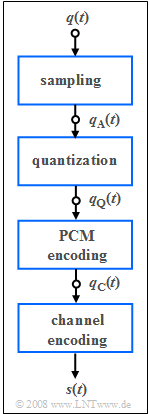Exercise 1.2: ISDN and PCM
The conversion of the analog speech signal q(t) into the binary signal qC(t) is done at ISDN ("Integrated Services Digital Network") according to the guidelines of "pulse code modulation" (PCM) by
- sampling in the interval TA=1/fA,
- quantization to M=256 discrete values,
- binary PCM encoding with N bits per quantization value.
The net data rate of a B channel ("Bearer Channel") is 64 kbit/s and corresponds to the bit rate of the redundancy-free binary signal qC(t).
However, because of the subsequent redundant channel coding and the inserted signaling bits, the gross data rate – i.e., the transmission rate of the transmitted signal s(t) – is greater.
A measure for the quality of the entire ISDN transmission system is the sink SNR
- ρv=PqPε=¯q(t)2¯[υ(t)−q(t)]2
as the ratio of the powers
- of the analog signal q(t) bandlimited to the range 300 Hz ... 3400 Hz
- and the error signal ε(t)=v(t)−q(t).
An ideal signal reconstruction with an ideal rectangular low-pass filter is assumed here for the sink signal v(t).
Notes:
- The exercise refers to the chapter "General Description of ISDN" of this book.
- Reference is also made to the chapter "Pulse Code Modulation" of the book "Modulation Methods".
Questions
Solution
(1) The quantization level number M is usually chosen as a power of two and for the number of bits N=log2(M).
- From M=28=256 follows N=8_.
(2) For the bit rate, RB=N⋅fA.
- Thus, from RB=64 kbit/s and N=8, we get fA=8 kHz_.
(3) Due to the bandwidth limitation, the highest frequency contained in the signal q(t) is equal to 3.4 kHz.
- Therefore, according to the sampling theorem, fA≥6.8 kHz should hold.
- With fA=8 kHz the condition is fulfilled ⇒ YES_.
(4) The last statement is correct:
- Even if the influence of the AWGN noise is small (small noise power density N0), the sink SNR ρv cannot fall below a limit given by the quantization noise:
- ρv≈ρQ=22M=216⇒ρv≈48dB.
- With larger noise interference, ρv can further (significantly) be reduced by the transmission errors.
- In contrast, sampling results in no loss of quality if the sampling theorem is obeyed.
- Sampling can then be completely undone if the source signal q(t) is bandlimited and the signal reconstruction is correctly dimensioned ⇒ ideal low-pass.
